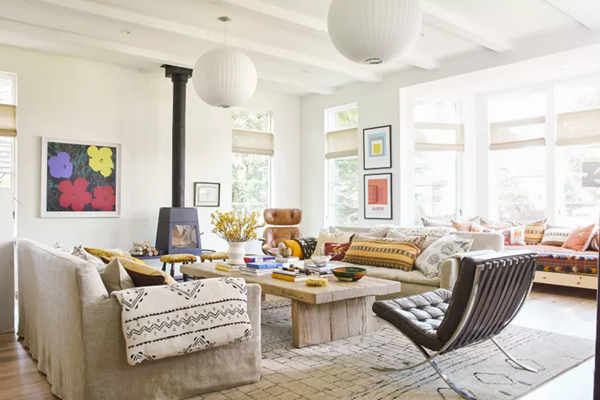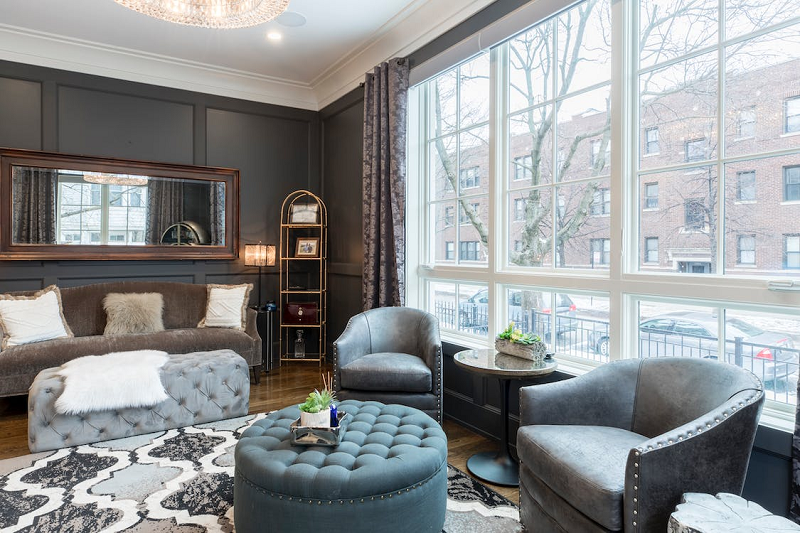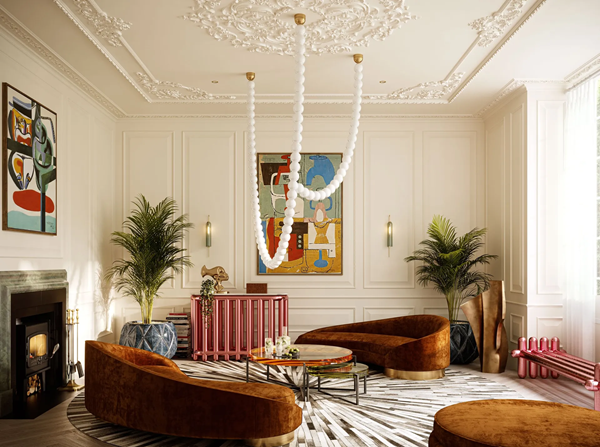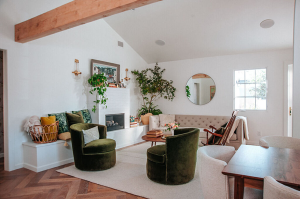The 60-30-10 rule might be the answer you’ve been searching for if you’ve ever stood in a paint store feeling completely overwhelmed by endless color choices. You’re not the only one! Choosing colors that work together feels impossible when you’re staring at thousands of options, wondering if that “perfect” blue will clash with your sofa or make your room feel cold and unwelcoming.

Here’s the good news: Professional interior designers have been using one simple formula for decades to create stunning, balanced spaces every time. This foolproof method takes the guesswork out of decorating and transforms any room from chaotic to cohesive in just three strategic color choices.
By the end of this guide, you’ll understand exactly how to apply the 60-30-10 rule in your own home. No more second-guessing your color decisions or expensive decorating mistakes. Just confidence and beautiful rooms that feel perfectly put together.
Ready to master the technique that makes color selection simple? Let’s dive in.
I. What Is the 60-30-10 Rule? (The Foundation)

The 60-30-10 rule is interior design’s most trusted formula for creating balanced color schemes. Think of it as your color roadmap. 60% of your room should feature one dominant color, typically a neutral that covers walls and large furniture pieces. 30% gets your secondary color – something bolder that adds personality through medium-sized elements like accent chairs or curtains. Finally, 10% is reserved for your accent color – the pop that brings everything to life through pillows, artwork, or decorative accessories.
Why these specific percentages? Your eye naturally seeks balance. Too much variety creates visual chaos. Too little creates boring monotony. This 60-30-10 split hits the sweet spot where rooms feel both harmonious and interesting.
- 60% keeps you grounded with a calming base color
- 30% adds character without overwhelming the space
- 10% provides excitement and easy seasonal updates
Picture This: Imagine walking into a living room with soft gray walls (60%), navy blue sofa and curtains (30%), and bright coral throw pillows and a vase (10%). Your eye moves smoothly from surface to surface, never jarred by competing colors or bored by sameness.
The beauty lies in its flexibility. You can use any three colors that speak to you, as long as you stick to the proportional formula. This rule works whether you love bold jewel tones or prefer soft pastels.
Pro Tip: High-end designers use this rule because it mirrors how our eyes naturally scan a room – from large surfaces to medium elements to small details.
Don’t Miss: Soft Autumn Color Palette: Room-by-Room Interior Design Guide
II. Why the 60-30-10 Rule Works So Well

Color psychology explains why this formula succeeds where random color combinations fail. Our brains process visual information by seeking patterns and hierarchy. When colors appear in balanced proportions, your mind can relax instead of working overtime to make sense of the space.
“The 60-30-10 rule is like a recipe for color. It provides a simple framework for creating balanced and visually pleasing spaces.” – Emily Henderson, founder of Emily Henderson Design.
Here’s exactly why the 60-30-10 rule creates such pleasing results:
- Prevents visual overwhelm by limiting your color choices to just three main hues
- Creates natural focal points where your 30% and 10% colors draw attention
- Allows personality without chaos by giving bold colors specific roles and boundaries
- Makes rooms feel larger because the dominant 60% color unifies the space
- Enables easy updates – change your 10% accent pieces for instant refreshes
Picture This: Compare two identical rooms – one decorated with six different colors scattered randomly, another following the 60-30-10 rule. The first feels busy and confusing. The second feels intentional and sophisticated, even with the exact same furniture.
According to recent home design studies, 81% of experts recommend warm neutrals to increase home value when selling, which perfectly aligns with using neutral tones for your 60% base color. This proves the rule’s effectiveness extends beyond aesthetics to actual property value.
Pro Tip: Before committing to paint or major purchases, test your color proportions using fabric swatches or paint samples arranged in 60-30-10 ratios on a white poster board.
Trending Post: How to Create a Soft Color Palette That Transforms Your Entire Home
III. How to Apply the 60-30-10 Rule in Any Room

Ready to put this formula into action? Follow this step-by-step approach to transform any space with confidence. The key is understanding where each percentage of color belongs and how to choose colors that work beautifully together.
The 60% – Your Dominant Color
Where it goes: This color covers your largest surfaces – walls, ceiling, and major furniture pieces like sofas or beds. Think of it as your room’s foundation.
Best choices for beginners: Neutral tones work beautifully here because they’re timeless and versatile. Consider warm whites, soft grays, beiges, or even pale versions of colors you love. These create a calm backdrop that lets your other colors shine.
- Warm white or cream – makes rooms feel larger and brighter
- Light gray – modern and sophisticated without being cold
- Greige (gray + beige) – combines warmth and contemporary style
- Pale blue or green – adds subtle color while staying calming
Avoid choosing bold colors for your 60%. A bright red wall might seem exciting at first, but it becomes overwhelming when it dominates the entire room.
The 30% – Your Secondary Color
Where it goes: Medium-sized elements like accent furniture, window treatments, rugs, or even an accent wall. This color adds personality and visual interest without taking over.
Placement strategies: Distribute this color around the room for balance. If you choose navy blue, you might use it for curtains on one side and an armchair on the other, creating visual rhythm.
This is where you can be braver with color choices. Rich blues, forest greens, warm terracotta, or deep purples all work beautifully as secondary colors. Just ensure they complement rather than clash with your 60% base.
The 10% – Your Accent Color
Where it goes: Small accessories, artwork, throw pillows, vases, lampshades, or decorative objects. These pieces pack the biggest visual punch despite their small size.
Why it’s powerful: Your accent color creates focal points and adds energy to the space. This is your chance to introduce trend colors, metallics, or bold hues that reflect your personality.
Smart choices: Metallics like gold or brass, jewel tones like emerald or ruby, or current trend colors work perfectly here because you’re using them sparingly.
Picture This: You walk into your living room where soft gray walls (60%) meet a rich navy sectional and curtains (30%), while pops of bright coral appear in throw pillows, a table lamp, and fresh flowers (10%). The room feels both calming and energetic.
Remember, these percentages don’t have to be exact. If you end up with 65-25-10 or 55-35-10, your room will still look balanced and intentional.
Pro Tip: Start with an inspiration piece – a beautiful throw pillow, piece of art, or decorative object you love – then build your 60-30-10 scheme around its colors.
Don’t Miss: Table Runners: A Complete Guide to Styles, Sizes, and Decorating
IV. Common 60-30-10 Rule Mistakes (And How to Avoid Them)

Even with this simple formula, it’s easy to make mistakes that throw off your room’s balance. Here are the most common pitfalls and exactly how to avoid them for perfect results every time.
“In interior design, there aren’t any hard and fast rules, but the formula gives people a jumping-off point to feel more confident when they’re designing on their own.” – Amanda Wyatt, designer and founder of Design Insider.
The biggest mistakes I see:
- Choosing three bold colors – This creates visual competition instead of harmony. Keep your 60% neutral and save bold choices for your 30% and 10%.
- Forgetting about natural light – Colors look completely different in north-facing vs. south-facing rooms. Always test colors in your actual space throughout the day.
- Ignoring undertones – A “warm” gray with yellow undertones won’t work with a “cool” blue that leans purple. Pay attention to whether colors are warm or cool.
- Over-thinking the percentages – Don’t stress about exact measurements. Visual balance matters more than mathematical precision.
- Not considering the whole home flow – Your 60% color should connect to other rooms so your home feels cohesive, not choppy.
Pro Tip: Use the “squint test” to check your color balance. Squint your eyes while looking at your room. If no single color overwhelms the space or if the room looks muddy, adjust your proportions.
Quick fixes for common errors: Too much color? Add more neutrals. Too boring? Introduce a bolder accent color through new accessories. Colors clashing? Check undertones and adjust accordingly.
Picture This: A room that started with bright yellow walls (60%), purple furniture (30%), and red accents (10%) gets transformed by switching to cream walls (60%), keeping the purple furniture (30%), and adding coral accents (10%). The difference is dramatic.
Don’t Miss: Top 15 Property Staging Mistakes to Avoid
V. 60-30-10 Rule Examples for Every Room

Let’s see how this formula works in real rooms. Each space has different needs, but the 60-30-10 rule adapts beautifully to any room’s function and style.
Living Room Example
60% – Warm white walls and cream sectional: Creates an open, airy feeling that makes the space feel larger. This neutral base works with any decorating style.
30% – Deep forest green: Appears in window panels, an accent chair, and a large area rug. This rich color adds sophistication without overwhelming.
10% – Brass and gold accents: Picture frames, lamp bases, side table legs, and decorative objects bring warmth and luxury to the space.
Bedroom Example
For a calming approach: Soft gray walls (60%), navy bedding and curtains (30%), coral accent pillows and artwork (10%).
For an energizing approach: Cream walls (60%), bold emerald green headboard and chair (30%), brass lamp and gold picture frames (10%).
Kitchen Example
Working with existing elements: If you have white cabinets and can’t change them, use white as your 60%. Add personality with colorful bar stools and window treatments (30%), then finish with colorful dishware displays or a vibrant backsplash (10%).
Bathroom Example
Small space considerations: Light colors work best for the 60% to maximize space. Try soft gray walls (60%), navy vanity and shower curtain (30%), and bright white or coral towels and accessories (10%).
Picture This: Your open floor plan flows seamlessly from living room to kitchen to dining room, all featuring the same warm white 60% base, but each area has its own unique 30% and 10% colors that reflect how you use each space.
Current 2024-2025 color trends favor soft, warm whites, warm neutrals, off-whites, and earthy greens, making them perfect choices for your 60% base colors that will stay stylish for years.
Pro Tip: Create flow between connected spaces by using the same 60% color throughout, then varying your 30% and 10% choices for each room’s personality.
Trending Post: 12 Designer-Approved Hanging Chair Tips for a Stylish Space
VI. Advanced 60-30-10 Rule Techniques

Once you’ve mastered the basics, these advanced techniques will elevate your decorating skills to professional levels. These strategies help you create more sophisticated, layered looks while maintaining perfect balance.
Beyond the basics:
- Use patterns within the rule – A patterned rug can contain all three of your colors, making it easier to tie everything together
- Consider texture as color – Natural wood, woven baskets, or metal finishes can count toward your color percentages
- Layer metallics strategically – Use metallics as your 10% accent, but choose one metal family (warm golds or cool silvers) for consistency
- Make seasonal adjustments – Keep your 60% and 30% consistent year-round, but switch your 10% accents seasonally
Pro Tip: Try the 60-30-10-10 variation for advanced users – use your traditional three colors, but add a fourth accent color that appears in just 5% of the space for extra sophistication.
Picture This: A sophisticated living room where cream walls and sofa (60%) meet navy chairs and curtains (30%), with both gold picture frames (5%) and coral flowers and pillows (5%) creating dynamic but balanced focal points.
When to break the rule: Experienced decorators sometimes use 70-20-10 for more dramatic results, or 50-30-20 when they want equal weight between two main colors. But master the classic formula first.
Dont’ Miss: How to Style a Curved Sofa for an Inviting Living Room
VII. Shopping for Your 60-30-10 Color Scheme

Smart shopping strategy makes the difference between a successful color scheme and a costly mistake. Here’s your practical guide to buying the right pieces in the right proportions without overspending.
“Your color palette can be sliced into three using the 60-30-10 rule: 60% of the space is a dominant color, 30% a secondary and complimentary color, and 10% an accent color,” says Amber Guyton, a designer according to Real Simple.
Your shopping game plan:
- Start with the 10% pieces – Find accent pillows, artwork, or accessories you love first, then build your larger color choices around them
- Test paint samples in your space – Colors look completely different under your home’s specific lighting conditions
- Budget 50% for your 60% color – Since this covers the largest areas, it represents your biggest investment
- Collect inspiration from everywhere – Pinterest, magazines, hotel lobbies, and even nature provide great color combinations
Pro Tip: Use digital tools like Adobe Color or Coolors.co to test color combinations before making purchases. Many paint companies also offer apps that let you visualize colors in your actual room.
Smart shoppers also know that buyers pay, on average, $2,512 more when a house has a kitchen painted in the moody gray hue, proving that following professional color rules pays off financially too.
Picture This: You start with a beautiful coral and gold throw pillow, then choose soft gray paint for your walls and a navy accent chair. Everything works perfectly together because you built the scheme systematically instead of buying random pieces.
Don’t Miss: How To Clean a Wool Rug
VIII. My Experience Using the 60-30-10 Rule
After helping dozens of clients transform their spaces over the past years, I can confidently say the 60-30-10 rule is the single most effective technique for creating beautiful, balanced rooms. I discovered this formula early in my design career when a mentor showed me how it could turn any color combination into a cohesive scheme.
What I’ve learned from real applications: The rule works with any color preference – from bold jewel tones to subtle pastels. The key is trusting the proportions and not overthinking the process. I’ve used it successfully in urban lofts, suburban family homes, and even small studio apartments.
This approach can help anyone increase their home values while creating spaces they genuinely love living in. It’s why I recommend starting here for anyone feeling intimidated by color choices.
Most Popular Post:
Interior Design Style Quiz
Timeless Paint Colors That Never Go Out of Style
Create Your Perfect Ergonomic Home Office: A Complete Guide
Must-Have Accessories for Guys: The Secret to a Stylish Space
Modular Sofas for Small Spaces: Brilliant Solutions for Compact Living
IX. Transform Your Space with Confidence
The 60-30-10 rule removes the guesswork from decorating and replaces it with a proven formula that works every single time. You now have the same tool that professional designers use to create those perfectly balanced, magazine-worthy rooms that always seem just out of reach.
Remember the key benefits: This simple formula prevents costly decorating mistakes, creates visual harmony in any space, allows you to incorporate colors you love safely, and makes it easy to update your decor as trends change.
Start with just one room. Choose your three colors, apply the 60-30-10 proportions, and watch as your space transforms from chaotic to cohesive. The confidence you’ll gain from seeing these results will inspire you to tackle other rooms in your home.
Your next step: Look around the room you’re sitting in right now. What would you choose as your 60% base color? What accent color would make you smile every time you see it? The beautiful, balanced space you’ve been dreaming of is just three color choices away.
The 60-30-10 rule isn’t just about decorating – it’s about creating a home that truly reflects who you are while making you feel calm, happy, and proud of your space every single day.
X. Frequently Asked Questions About the 60-30-10 Rule
What exactly is the 60-30-10 rule in interior design?
The 60-30-10 rule is a color distribution formula that helps create balanced room designs. 60% of a room’s color should be a dominant hue, 30% should be a secondary color, and 10% should be an accent color. This creates visual harmony without overwhelming the space or making it feel boring.
Do I have to follow the percentages exactly?
No, the percentages don’t need to be mathematically precise. These proportions prevent your chosen colors from feeling too overpowering or, alternatively, from being too minimal to notice. Think of it as a guideline rather than a strict rule. Whether you end up with 65-25-10 or 55-35-10, your room will still look balanced.
Can I use more than three colors with this rule?
Yes! You can add a fourth color to the mix by doing something like 60-30-10-10, adding a second accent color in your accessories such as throw pillows, vases on shelves, picture frames. This advanced technique works well for sophisticated, layered looks.
What’s the best 60% dominant color for beginners?
Neutral colors work best for your 60% because they’re versatile and timeless. Popular choices include warm white, light gray, greige (gray-beige blend), or soft beige. These create a calming foundation that makes it easier to choose your 30% and 10% colors confidently.
Where should I place each color percentage in my room?
60 percent of the scheme should be one color, 30 percent should be a second accented color, displayed on chairs, rugs, sofas, and 10 percent should be a third color dotted around the room in the form of artwork, small touches and accessories. The 60% typically covers walls and large furniture, 30% appears in medium elements, and 10% shows up in small decorative pieces.
Can I use bold colors with the 60-30-10 rule?
Absolutely! The key is using bold colors strategically. Keep your 60% neutral, then use bold colors for your 30% secondary color (like a bright blue sofa) or your 10% accent (like vibrant orange throw pillows). This way, you get personality without visual chaos.
How do I choose colors that work well together?
Start with an inspiration piece you love – a throw pillow, artwork, or rug that contains multiple colors. Pull your three colors from this piece. Alternatively, use a color wheel to choose complementary colors (opposite each other) or analogous colors (next to each other) for foolproof combinations.
Does this rule work in small spaces like bathrooms?
Yes! The 60-30-10 rule works especially well in small spaces because it prevents visual clutter. In a small bathroom, you might use light colors for your 60% to maximize the feeling of space, then add personality through colorful towels (30%) and small accessories (10%).
Can I change my colors seasonally using this rule?
Definitely! This is one of the rule’s biggest advantages. Keep your 60% and 30% colors consistent year-round, then swap out your 10% accent pieces seasonally. Change throw pillows, artwork, flowers, or decorative objects to refresh your space without major renovations.
What if I have existing furniture that doesn’t fit the rule?
Work with what you have! If you own a bold red sofa that you love, make red your 30% secondary color and choose a neutral 60% color for your walls. Then select a complementary accent color for your 10%. The rule adapts to your existing pieces.
Does the 60-30-10 rule apply to patterns and textures too?
Yes, patterns and textures can be part of your color scheme. A patterned rug containing all three of your colors can help tie everything together. Natural wood tones, metallics, and textured fabrics can also count toward your color percentages.
How do I know if my room balance is working?
Try the “squint test” – squint your eyes while looking at your room. If no single color dominates overwhelmingly and the space feels harmonious rather than chaotic or boring, your balance is working. You should be able to easily move your eyes around the room without any jarring color clashes.
Can I use this rule for an entire house or just individual rooms?
You can use it both ways! For individual rooms, apply the rule completely within each space. For whole-house flow, consider using the same 60% color throughout connected areas, then vary your 30% and 10% colors to give each room its own personality while maintaining cohesion.
Is there a wrong way to use the 60-30-10 rule?
The important thing to remember is this is just a general, and customisable, guide. Creativity has no set rules or order – it is all subjective and down to personal preference and imagination. The main mistake is choosing three equally bold colors or ignoring lighting conditions in your space.
How much should I budget for each color percentage?
Budget approximately 50% of your decorating budget for your 60% color since it covers the largest areas (paint, major furniture). Allocate 35% for your 30% elements (accent furniture, window treatments), and 15% for your 10% accessories (pillows, artwork, decorative objects).
Subscribe To the Newsletter!
Subscribe now for an endless feed of inspirational women’s cave decor ideas, pampering rituals, and more tips for curating your ultimate escape. Let’s start making your cozy refuge a reality – you so deserve this!
CATCH THE LATEST IN HOME DECOR TRENDS:

Steal These 16 Expert-Approved Decorating Secrets

How To Accessorize Your Living Room

Small Space? 10 Ways To Make A Room Appear Bigger

Make Your space Look Expensive
GET CAUGHT UP ON ALL THE INSPIRING DECOR TIPS:

18 Fresh Decorating Ideas To Update Your Fireplace

How To Create An Art Gallery Wall



